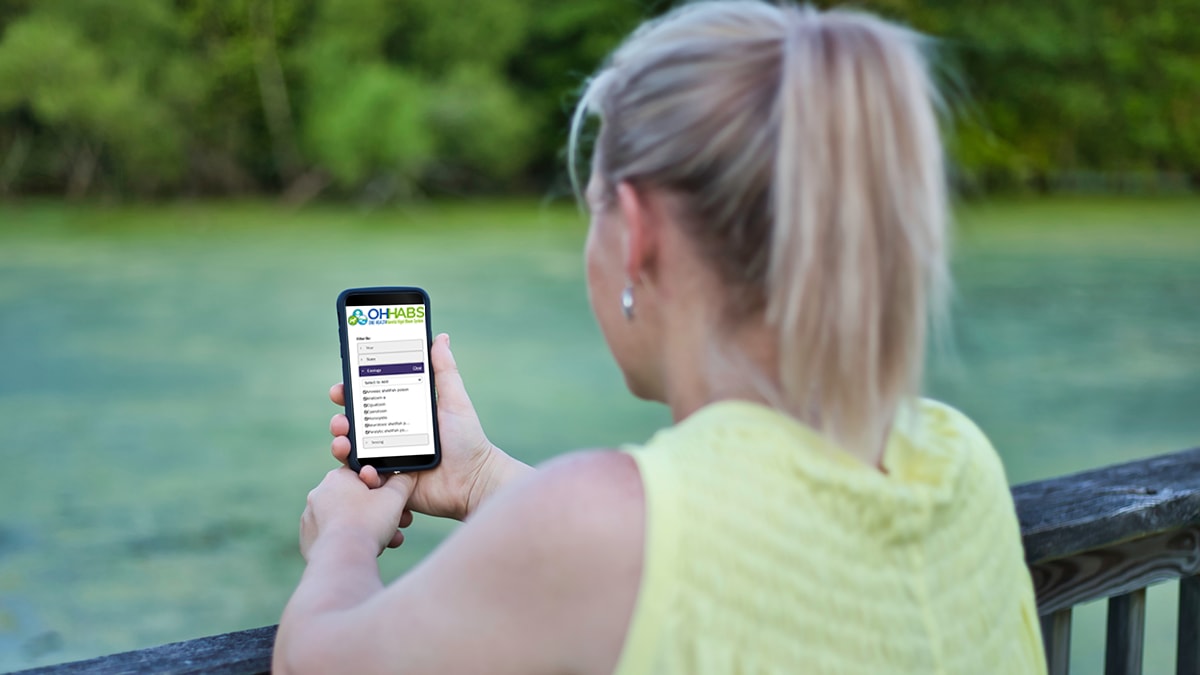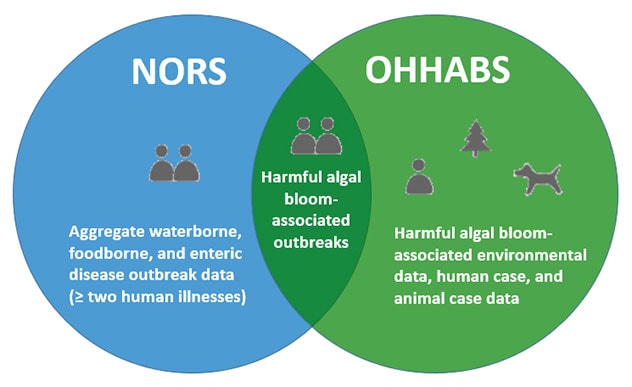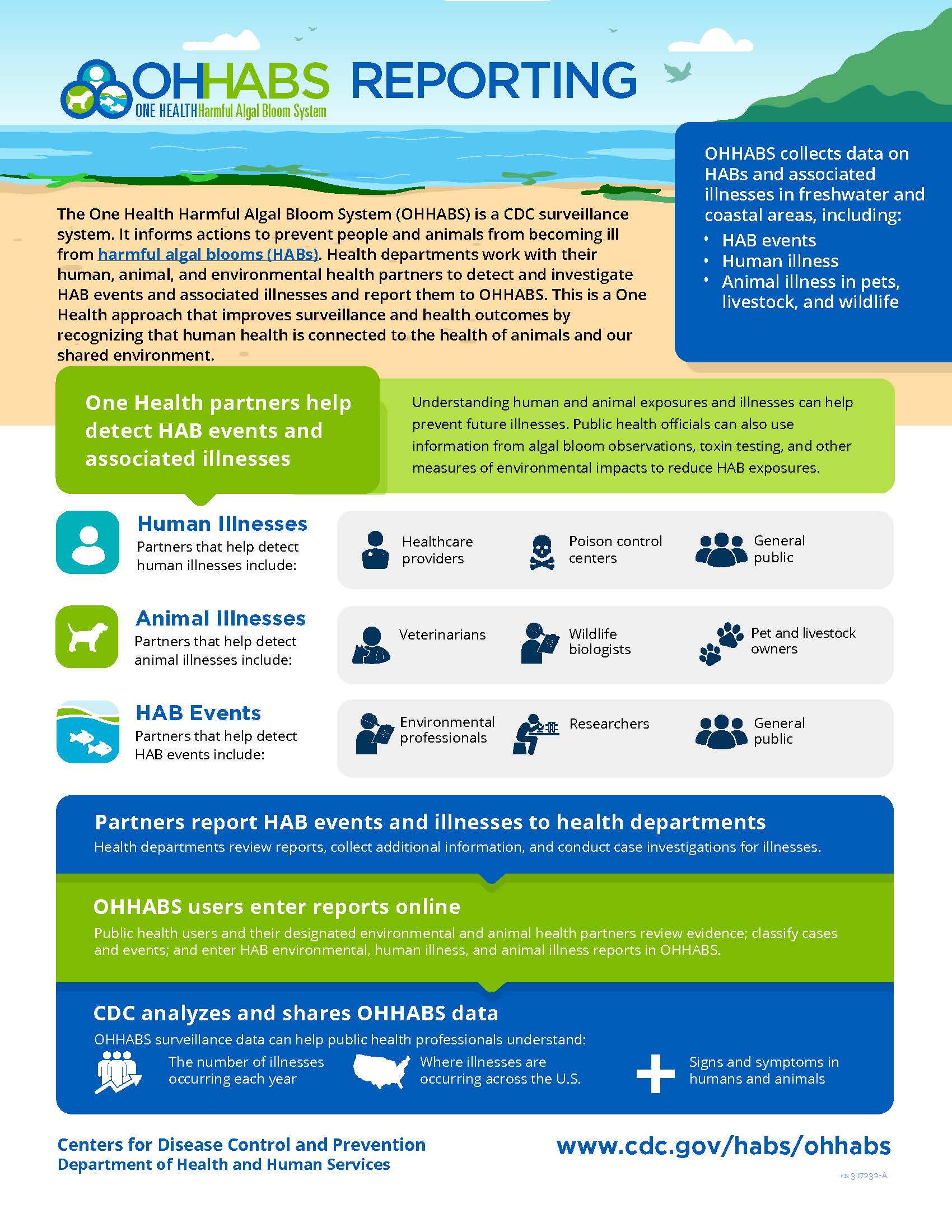Key points
- CDC's One Health Harmful Algal Bloom (OHHABS) is a reporting system available to state and territorial public health departments and their designated partners.
- OHHABS gathers information to understand harmful algal blooms better and prevent associated illnesses.

Overview
Health departments in U.S. states and territories are the primary reporters to OHHABS. These health departments work with additional partners to identify harmful algal blooms and human and animal illnesses.
In most cases, health departments report directly to OHHABS, but they can also designate animal health and environmental health partners to report harmful algal blooms. Partners and staff at agencies that report to OHHABS can use the following resources to collect and report information.
Reporting
Health departments and designated partners can report information in OHHABS by either directly entering information into the online system or importing PDF forms. These PDF forms can be used by partners without direct access to OHHABS to collect and share information with people who report in OHHABS.
- Read the instructions for importing fillable or static PDF forms.
- Use the fillable forms for electronic use or print and fill out the static PDF forms by hand.
Forms
Use the environmental form (fillable) or (static) to report harmful algal blooms in water bodies or information about the most likely food source for foodborne illnesses.
Use the human case form (fillable) or (static) to report individual cases of human illnesses.
Use the animal case form (fillable) or (static) to report individual or multiple cases of animal illness, including cases in:
- Pets such as dogs, cats, parrots and guinea pigs.
- Livestock such as cattle, sheep, goats, chicken, pigs, and horses.
- Wildlife such as birds, sea lions, fish and deer.
Keep in mind:
Harmful algal blooms can be reported even if there are no associated human or animal cases of illness. Submit a report to both the National Outbreak Reporting System (NORS) and OHHABS if multiple people become ill following an exposure to a harmful algal boom. You can report animal cases of illness individually (e.g., single dog, single sea lion) or at the group level for multiple animal cases (a fish kill, a herd of cattle, a flock of birds). You can indicate whether you are reporting a single case or a group of animal illnesses. Where possible, single case reporting is preferred.
Form guidance
Use the documents below to help you report in OHHABS:
- Environmental form guidance: report a harmful algal bloom.
- Human form guidance: report a human case of illness.
- Animal form guidance: report an animal case of illness.
- Foodborne illness form guidance: report cases of foodborne illnesses.
- Multistate reporting guidance: report a harmful algal bloom and associated illnesses impacting more than one state.
- Algae algal toxins and other pathogen list: classify algae and algal toxins in the environmental, human, and animal forms.
Before reporting in OHHABS, use the human case or animal case public health assessment tool to assess whether a human or animal illness was likely caused by an exposure to a harmful algal bloom.
Technical assistance
- Sign in and get started to log into OHHABS and use its features.
- Navigate reports to create, edit, finalize, and share reports.
- Use the OHHABS data dictionary to understand or analyze the data and format entered in OHHABS.
- Use the harmful algal bloom and case definitions to make appropriate classifications.
Support reporting
How to support reporting in OHHABS:
- If you are a public health, environmental health, or animal health professional, contact your state's OHHABS Reporting Site Administrator (RSA) to gain access. Email OHHABS@cdc.gov for assistance on identifying or contacting your state's OHHABS RSA.
- If you are a healthcare provider or veterinarian, report illnesses caused by harmful algal blooms to your local or state health department.
- If you are a member of the public and would like to report a harmful algal bloom or related illness, contact your local or state health department.
Frequently asked questions
OHHABS was built on the National Outbreak Reporting System (NORS) platform, and the two systems have a similar interface. However, NORS and OHHABS capture different types of harmful algal blooms data.
NORS is a reporting system for foodborne, waterborne, and enteric disease outbreaks. It can collect harmful algal bloom-associated aggregate outbreak data, meaning summary data describing two or more people.
OHHABS is a reporting system for harmful algal blooms and associated human and animal illness. A harmful algal bloom-associated outbreak can be reported in both NORS and OHHABS.


